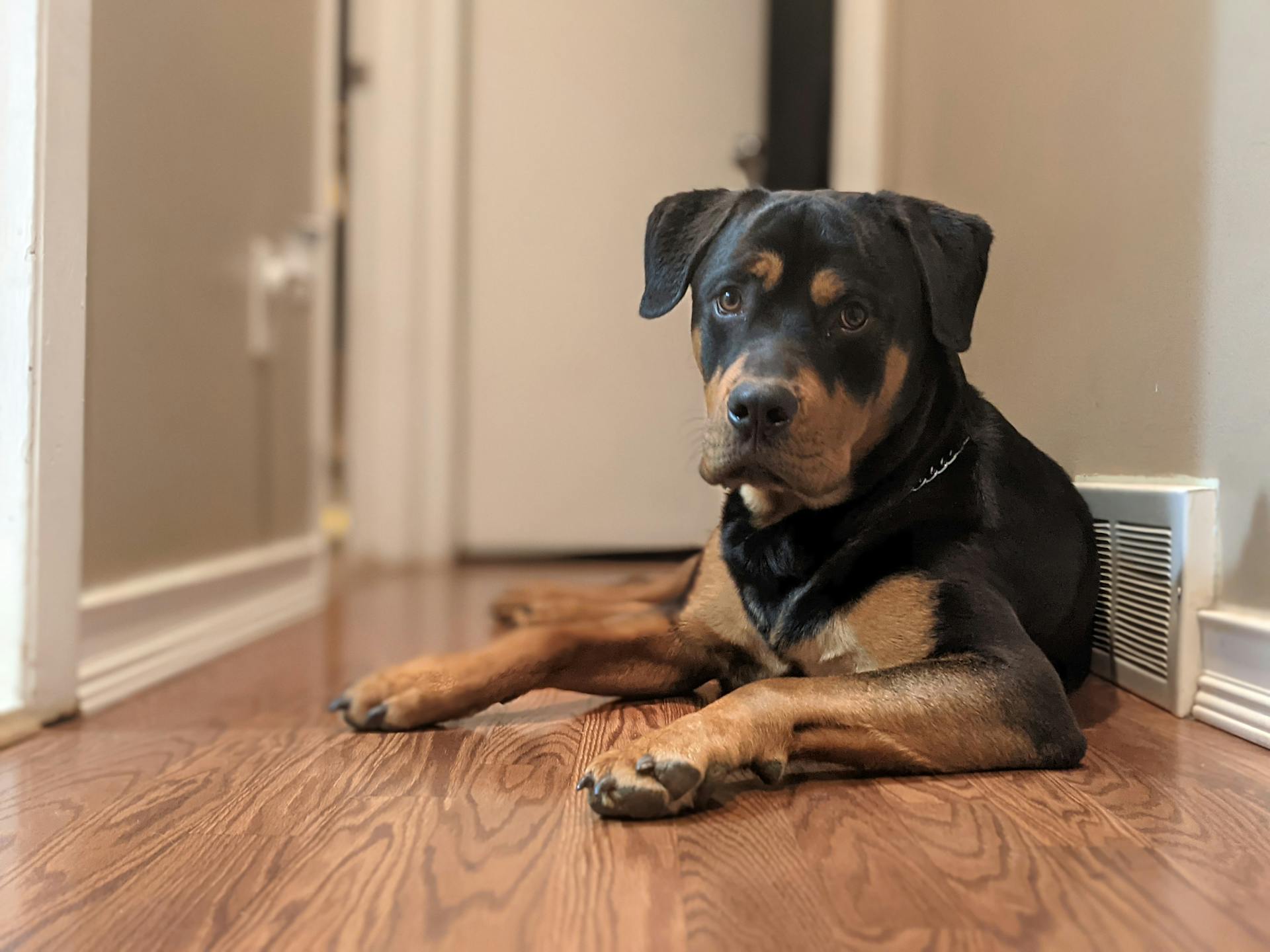
Choosing the right Rottweiler puppy can be a daunting task, but understanding the basics of breeding can make all the difference. A reputable breeder will have their Rottweilers registered with a kennel club, such as the American Kennel Club (AKC).
Rottweilers are a loyal and loving breed, but they do require regular exercise to stay happy and healthy. Aim for at least 30 minutes of exercise per day, which can include walks, runs, or playtime in the yard.
Rottweiler puppies are born with their eyes closed and don't open them until around 10-14 days old. This is a normal developmental milestone and not a cause for concern.
As a responsible Rottweiler owner, it's essential to socialize your puppy from an early age to prevent behavioral problems later on. This can be done by introducing your puppy to new people, places, and experiences.
Related reading: Traits of Rottweilers
Physical Characteristics
The Rottweiler's head is of medium length, relatively broad between the ears, with a moderately arched forehead line and well-developed occipital bone. The nose is well-developed, broad, and black, with relatively large nostrils.
Their muzzle should appear neither elongated nor shortened in relation to the cranial region, with a ratio between the length of the muzzle and the length of the skull of about 1 to 1.5. The lips are black and close fitting, with the corner of the mouth not visible.
Their eyes are of medium size, almond-shaped, and dark brown in color, with close-fitting eyelids that should not droop. The ears are medium-sized, pendant, triangular, wide apart, and set high on the head.
Here are the key physical characteristics of Rottweilers:
- Head: medium length, relatively broad between the ears
- Nose: well-developed, broad, and black
- Eyes: medium size, almond-shaped, and dark brown in color
- Ears: medium-sized, pendant, triangular, wide apart, and set high on the head
The Rottweiler's body is strong and firm, with a straight back, short, strong, and deep loins, and a broad, medium-length croup that is slightly rounded. Their chest is roomy, broad, and deep, with a well-developed forechest and well-sprung ribs.
Physical Characteristics
Rottweilers are large dogs with a distinctive appearance. They typically have short, dense, and double-coated fur.
Their coat is usually black with tan markings, but a recessive gene can sometimes create a long-haired Rottweiler. Their size is a key characteristic, making them a large breed.
Worth a look: Large Bully Breeds
A Rottweiler's head is a notable feature, with a powerful appearance that doesn't lack nobility. Their eyes, snout, teeth, tongue, dewlap, and throat are all part of this impressive head.
Here's a breakdown of the key physical characteristics of a Rottweiler:
Their legs are strong and powerful, with thighs and hips that are well-suited to their size. Their tail is a distinctive feature of the Rottweiler breed.
Body
The back is straight, strong and firm. This is a key characteristic of the Rottweiler breed.
The loins are short, strong and deep. This helps to create a sturdy and robust build.
The croup is broad, of medium length, and slightly rounded. This provides a stable and balanced base for the dog.
The chest is roomy, broad and deep, making up about 50% of the shoulder height. This indicates a strong and athletic build.
The flanks are not tucked up, giving the Rottweiler a distinctive and impressive physique.
Check this out: Bullmastiff Giant Rottweiler
Limbs
The front legs of this breed are straight and not close together when viewed from the front. The forearm is straight and vertical when seen from the side, with a strong and muscular development.
The shoulders are well laid back, providing a solid foundation for the front legs. The upper arm is close fitting to the body, ensuring a smooth and efficient movement.
The front feet are round, tight, and well arched, with hard pads and short, black, and strong nails. The pasterns are slightly springy, strong but not steep.
From the rear, the legs are straight and not too close together. The upper thigh is moderately long, broad, and strongly muscled.
The lower thigh is long, strongly and broadly muscled, with a sinewy texture. The hocks are sturdy and well-angulated, not steep.
The hind feet are slightly longer than the front feet, with strong and arched toes.
Intriguing read: When Do Rottweilers Calm down
Coat Color and Grooming
A Rottweiler's coat is one of their most distinctive features, and it's relatively low maintenance. Their short, double coat is straight and coarse, with a medium-length outer coat and a thick undercoat that's mainly found on the neck and thighs.
Additional reading: Blowing Husky Coat
The outer coat is typically black with rust to mahogany markings, which appear on the face, chest, and legs. Tan lines that resemble pencil marks can also be found on the toes.
Brushing your Rottweiler weekly with a firm bristle brush can help remove dead hair and distribute skin oils, keeping their coat shiny and healthy. They'll shed twice a year, so you'll want to brush more frequently during these times to keep loose hair under control.
Here's a quick rundown of Rottweiler grooming needs:
- Brush weekly to remove dead hair and distribute skin oils
- Brush more frequently during shedding season (twice a year)
- Bathe as needed, but avoid bathing in cold weather
- Brush teeth at least two or three times a week to prevent tartar buildup and bad breath
Regular grooming can also help you bond with your Rottweiler and lay the groundwork for easy veterinary exams and handling when they're an adult.
Coat and Color
Rottweilers have a short double coat that's straight and coarse. The outer coat is medium in length, shorter on the head, ears, and legs.
Their undercoat is found mainly on the neck and thighs, and the amount of undercoat they have depends on the climate they live in. In hot climates, Rottweilers may acclimatize and be missing the undercoat.
See what others are reading: Dog Blowing Coat in Winter
A Rottweiler's coat is always black with markings that are rust to mahogany. The markings appear over the eyes, on the cheeks, on each side of the muzzle, on the chest and legs, and beneath the tail.
There are also tan lines that resemble pencil marks on the toes. Brushing your Rottweiler weekly with a firm bristle brush can help remove dead hair and distribute skin oils.
Rottweilers shed twice a year, and you'll probably want to brush more frequently to keep the loose hair under control. Brushing their teeth at least two or three times a week can help remove tartar buildup and bacteria inside their mouth.
The colour and markings of a Rottweiler are very distinctive, with clearly defined markings of a rich tan on the cheeks, muzzle, throat, chest, and legs.
Check this out: Brushing a Bichon Frise
Size and Temperament
Size and temperament are crucial factors to consider when breeding Rottweilers. A Rottweiler's size can vary, with males standing 61–69 cm (24–27 in) at the withers and weighing between 50 and 60 kg (110 and 132 lbs), while females stand 56–63 cm (22–25 in) and weigh between 35 and 48 kg (77 and 105 lbs).
The ideal weight must be relative to height, and breeding dogs must pass a breed suitability test that includes physical conformation and reactions to gunshots. This test, known as the ZTP, evaluates crucial Rottweiler qualities and is required by the ADRK before registered dogs can enter breeding programs.
Rottweilers are highly intelligent and confident, with a strong instinct to guard and protect. They can make playful and gentle family pets, but experts recommend them as good pets for more experienced owners who can provide proper training and handling.
Size
Rottweilers are a medium to large breed, with males typically standing between 61 and 69 cm tall at the withers.
Their weight is directly proportional to their height, and males usually weigh between 50 and 60 kg.
Rottweilers are also known for their muscular build, which requires regular exercise to maintain.
Males typically weigh between 110 and 132 lbs, while females weigh between 77 and 105 lbs.
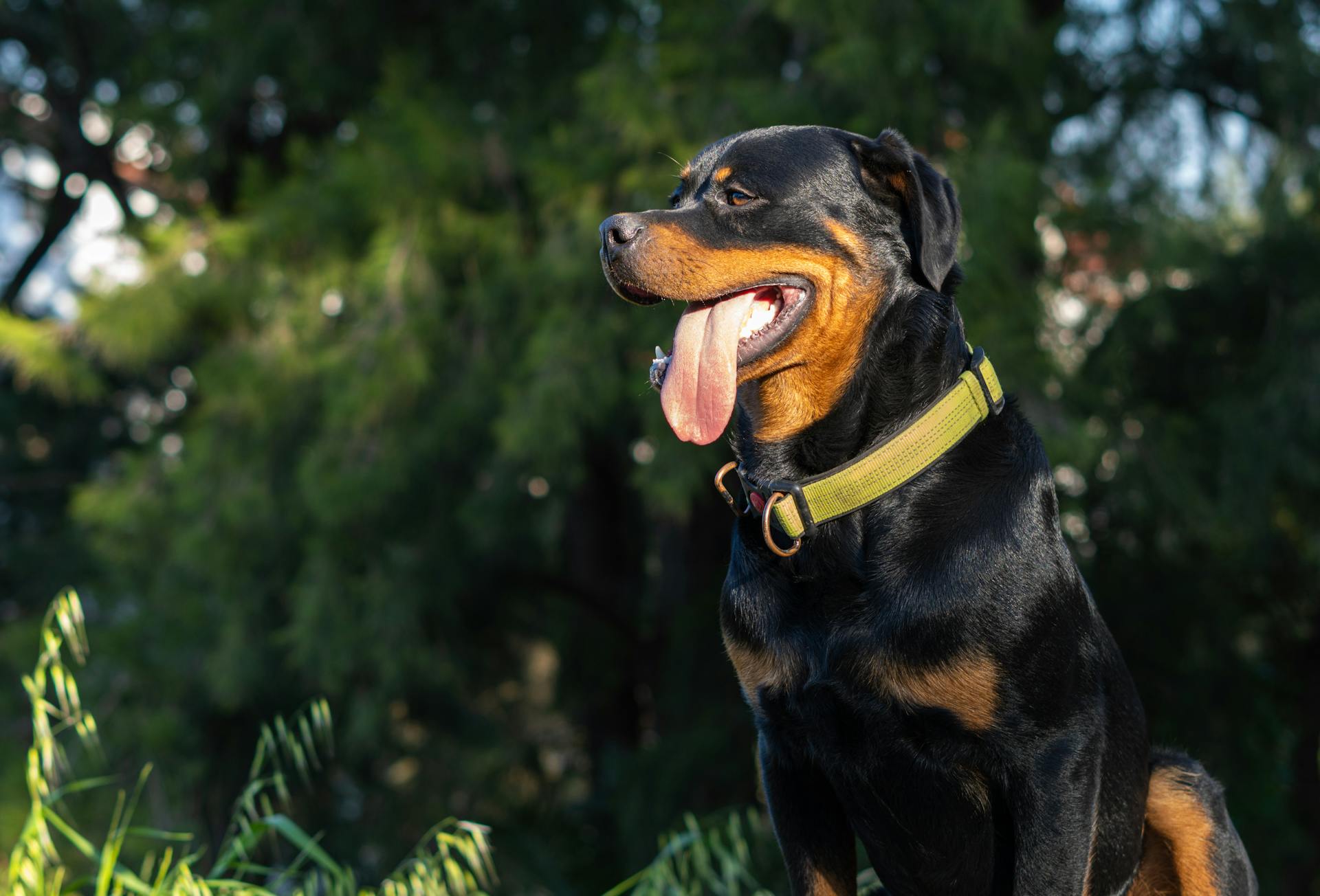
The height range for males is between 24 and 27 inches at the shoulder, while females are slightly smaller, standing between 22 and 25 inches tall.
This variation in size is what makes the Rottweiler breed so versatile and adaptable to different living situations.
Females, on the other hand, tend to be on the smaller side, weighing between 85 and 115 pounds.
Their size is also a testament to their strength and agility, making them a popular choice as both family pets and working dogs.
Temperament
Temperament plays a crucial role in determining the overall behavior and personality of a Rottweiler.
Rottweilers are highly intelligent and confident dogs, making them excellent service and police dogs. They thrive on stimulation and exercise, and grasp new commands quickly.
A Rottweiler's temperament can be influenced by several factors, including heredity, training, and socialization. Puppies with nice temperaments are curious and playful, willing to approach people and be held by them.
For another approach, see: Bullmastiff Rottweiler Cross
In fact, meeting at least one of the parents, usually the mother, is essential to ensure they have a nice temperament you're comfortable with. This can give you an idea of what a puppy will be like when it grows up.
While Rottweilers are naturally protective of their family and property, they should never be aggressive towards people without cause. They are calm, confident, and courageous dogs that are self-assured and aloof, taking a wait-and-see attitude with new people or situations.
However, they can be stubborn at times, making consistent and firm training essential. A sharp word is often a sufficient reprimand, but only if you've established your leadership.
Here's an interesting read: Why Do They Cut Rottweilers Tails off
Health and Care
Rottweilers are prone to several health issues, including cancer, which is the most common cause of death in the breed, accounting for over 45% of deaths.
Skin conditions like acral lick dermatitis, calcinosis cutis, and follicular lipidosis are also common in Rottweilers.
Recommended read: Common Health Issues with Rottweilers
Canine hip dysplasia and cranial cruciate ligament deficiency are two conditions that Rottweilers are predisposed to, with a prevalence of 20.1% and 38.1% respectively.
Regular exercise is essential for Rottweilers, and they need at least a couple of 10- to 20-minute walks each day, as well as playtime with balls and hiking.
Health
The Rottweiler's life expectancy is a concern, with studies showing an average life expectancy of 8-10.6 years, lower than the average of 12 years for purebreds and 12 for crossbreeds.
Cancer is the most common cause of death in Rottweilers, accounting for over 45% of deaths in the breed.
The Rottweiler is prone to several skin conditions, including acral lick dermatitis, calcinosis cutis, and lupoid onychodystrophy.
Follicular lipidosis, a skin condition, is found in red point dogs like the Rottweiler.
Canine hip dysplasia is a significant issue in Rottweilers, with 10.53% of dogs having the condition, compared to 3.52% overall.
If this caught your attention, see: Lakeland Terrier Life Expectancy
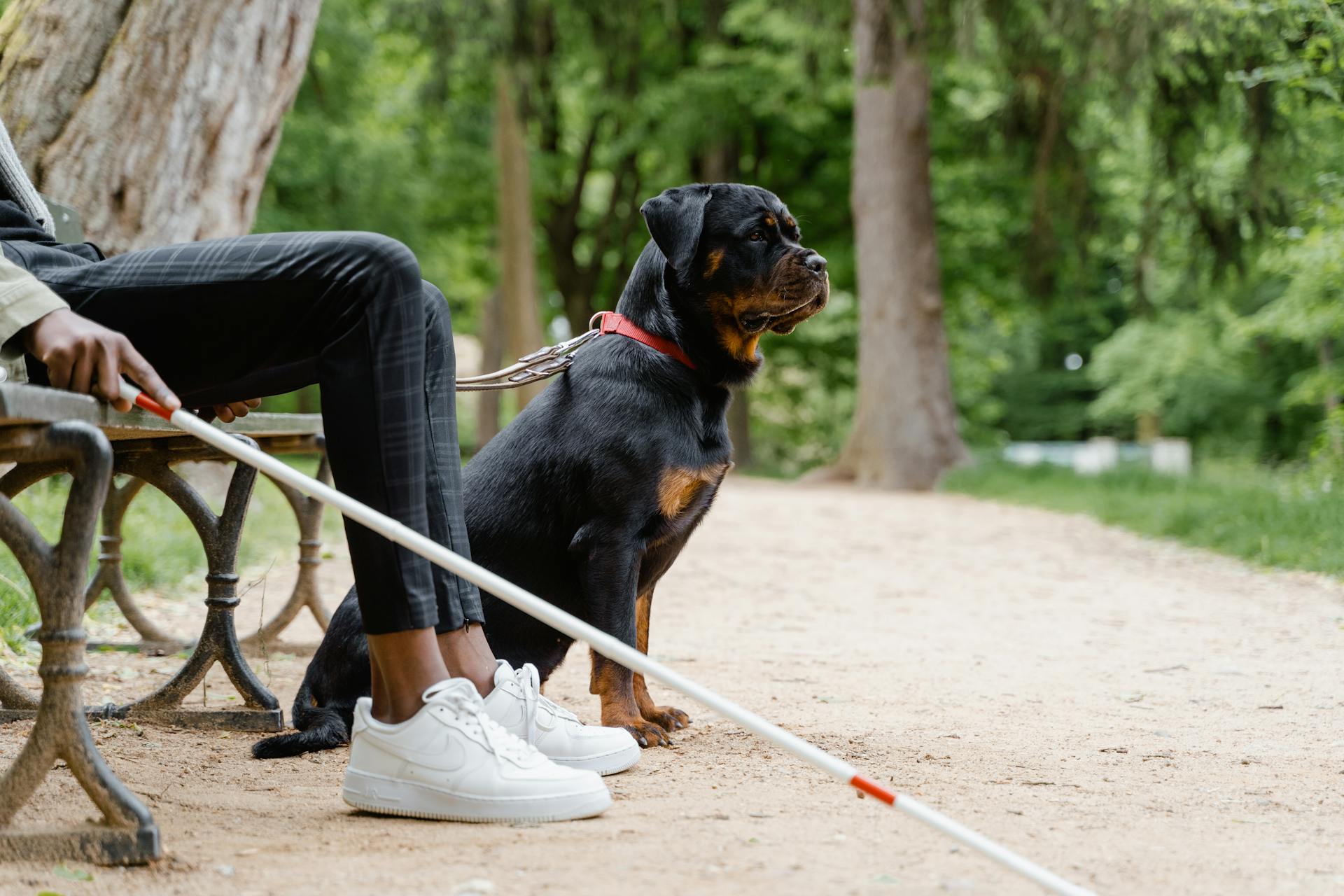
The Rottweiler also has a high prevalence of cranial cruciate ligament deficiency, with 8.29% of dogs having the condition.
Hip dysplasia and elbow dysplasia are common in Rottweilers, with a prevalence of 20.1% and 38.1% respectively.
Gastric dilatation volvulus, a potentially life-threatening condition, has been linked to Rottweilers in some studies.
Take a look at this: Hip Dysplasia in Rottweilers
Grooming
Grooming is an essential part of Rottweiler care. It's not only about making them look good, but also about keeping them healthy.
To start, Rottweilers have a short double coat that sheds twice a year, so be prepared to brush them more frequently during these periods. You'll need a firm bristle brush to remove dead hair and distribute skin oils.
A weekly brushing session will help keep their coat shiny and healthy. If you're not comfortable bathing them outdoors, it's best to do it indoors.
Don't forget to brush their teeth at least two or three times a week to prevent tartar buildup and gum disease. Daily brushing is even better.
Here's a quick rundown of what to check during grooming:
- Check their ears often for signs of infection, such as a strange smell or black or brown wax.
- Look for lumps or signs of parasites on their bodies.
- Brush their teeth regularly to keep their gums healthy and prevent bad breath.
Nutrition
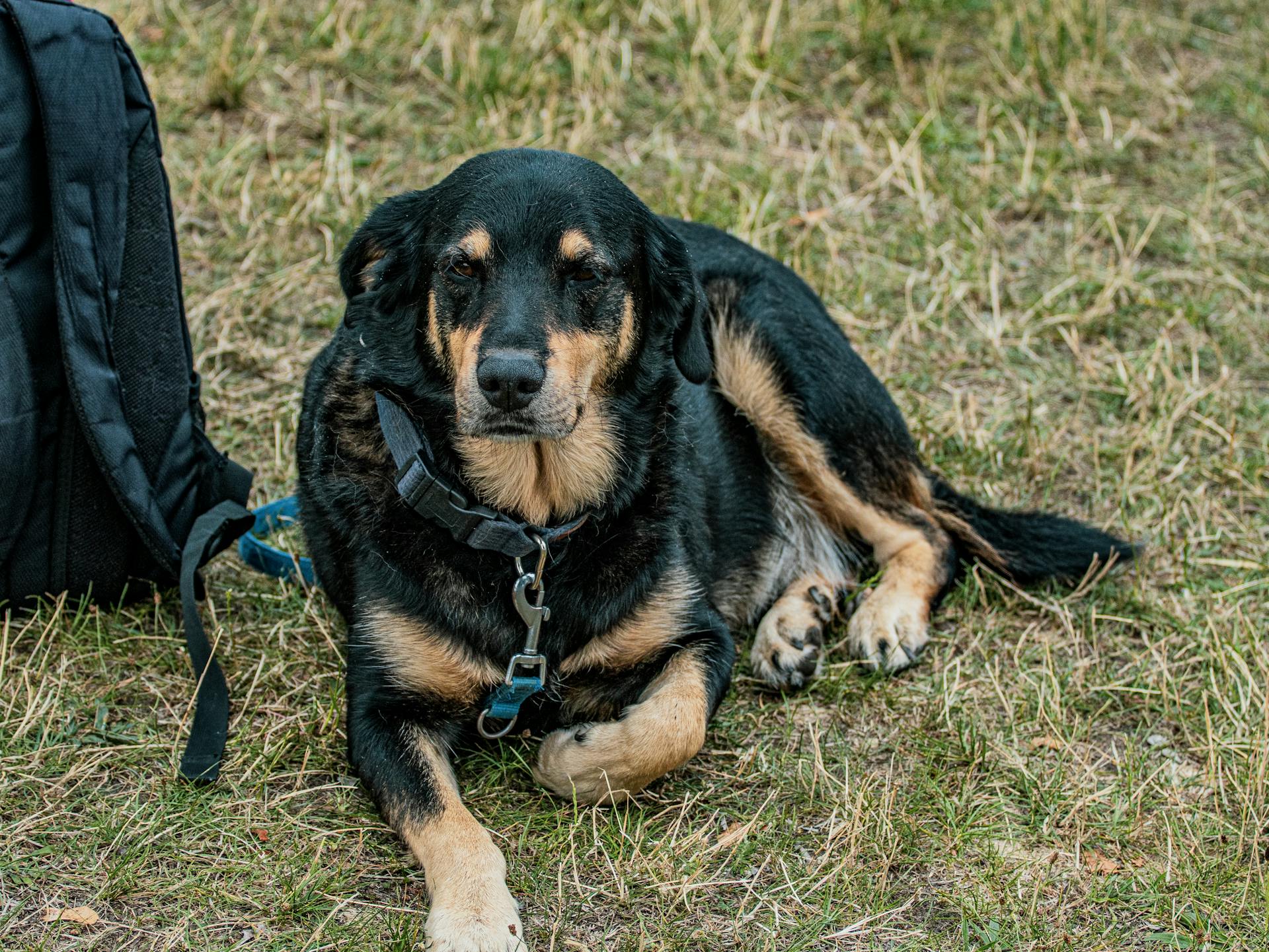
Nutrition plays a crucial role in maintaining your Rottweiler's overall health. Feeding your Rottweiler two smaller portions a day can help prevent bloat, a serious condition where the stomach becomes twisted.
It's essential to choose a high-quality pet food that suits your dog's age, size, and activity levels. You can find guidelines on the food packaging to help you make an informed decision.
Rottweiler puppies may experience tummy trouble occasionally, but sticking to the same feeding schedule and routine as their breeder can help prevent digestive issues.
If you need to change your dog's diet, do it gradually over the course of a few weeks. This will help prevent digestive upset and ensure a smooth transition.
If you notice any digestive issues, such as vomiting or diarrhea, seek veterinary advice immediately.
Here's a quick guide to help you choose the best food for your Rottweiler:
Care
Rottweilers need to live in the home with their people, as they can become bored, destructive, and aggressive if left alone in a backyard all the time.
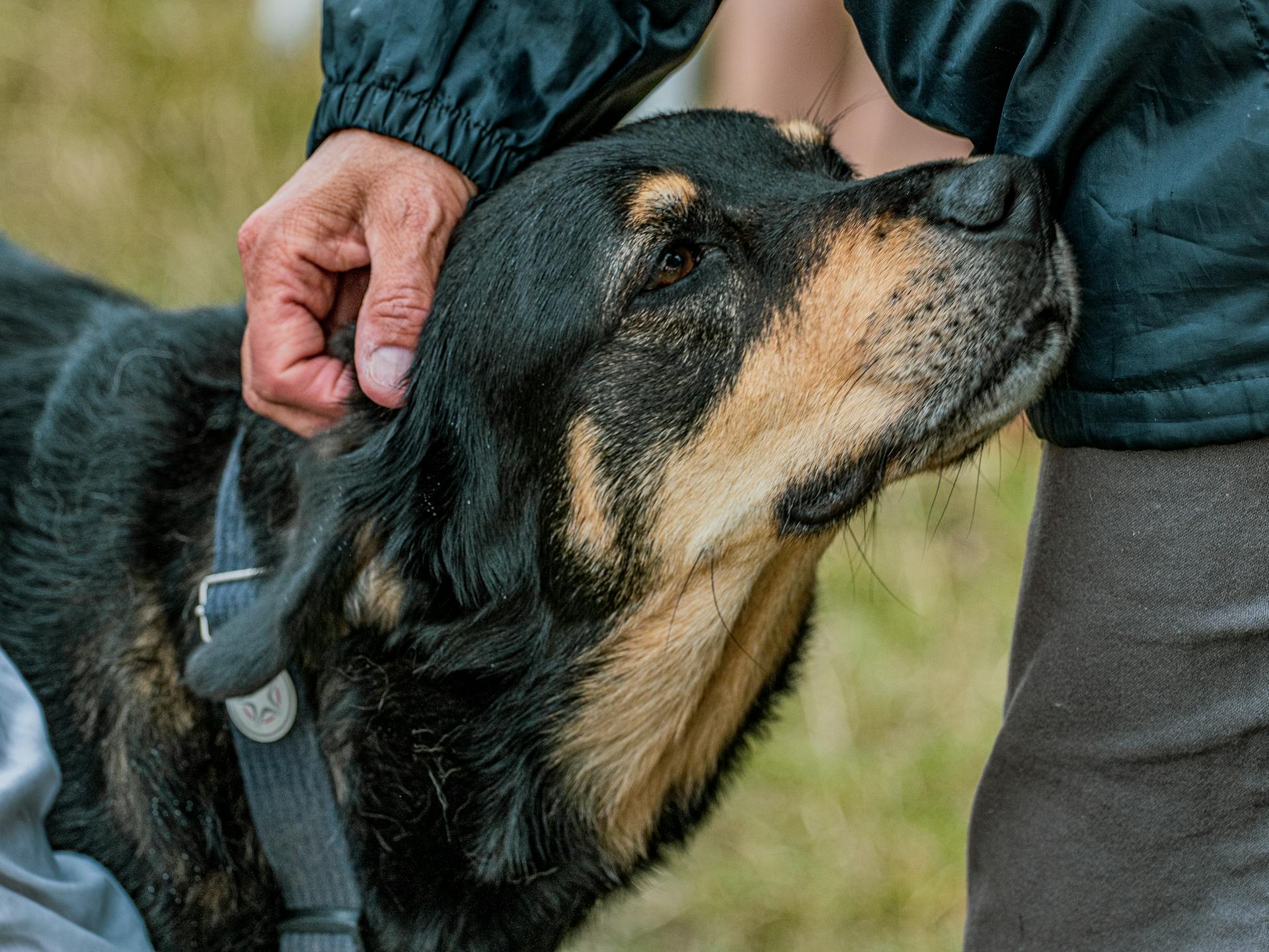
A Rottweiler is a homebody, but he requires a fenced yard to protect him from traffic and because he can be aggressive toward other dogs and strangers who come onto his property.
Don't rely on an underground electronic fence to keep your Rottie in your yard, as it won't prevent people or other animals from coming onto your property.
A sign advising strangers and non-family members not to come onto your property without your escort is a good idea.
Rottweilers have varying energy levels, ranging from couch potato to whirlwind, so be sure to tell the breeder what kind of energy level suits you.
Moderately active Rottweilers will appreciate a couple of 10- to 20-minute walks each day, and they also enjoy playing with balls and going hiking.
More energetic Rotties may need longer exercise times and more structured activities to keep them happy and healthy.
Their athleticism, intelligence, and trainability make them well suited to activities like agility and obedience competition, as well as tracking and therapy work.
To train your Rottweiler effectively, remember that he thrives on mental stimulation and likes to learn new things.
Be fair, consistent, and firm when training your Rottweiler, and he'll reward you with his quick learning ability.
With a consistent schedule, no opportunities to have accidents in the house, and positive reinforcement when he potties outdoors, housetraining your Rottweiler shouldn't be difficult.
Here's an interesting read: Activities for Dogs with High Prey Drive
Frequently Asked Questions
Are Rottweilers a difficult breed?
Rottweilers can be a challenging breed to own due to their strong will and potential for aggression, requiring a firm and patient owner. With proper training and care, however, they can thrive as loving and loyal companions.
What two dogs make a Rottweiler?
Rottweilers originated from the cross between mastiff-like dogs and local sheepdogs in Germany. Specifically, they descended from ancient Roman cattle-herding dogs and German sheepdogs.
How many puppies can a Rottweiler have in first litter?
A first-time Rottweiler mother can have as few as 2 puppies in her litter. Litter size can vary, but 2 is a normal number for a first-time mom.
At what age is best to breed a Rottweiler?
For optimal health and well-being, Rottweilers should not be bred before 18 months of age, equivalent to 20 human years of maturity. Breeding too early can lead to behavioral issues in adult dogs.
Featured Images: pexels.com


